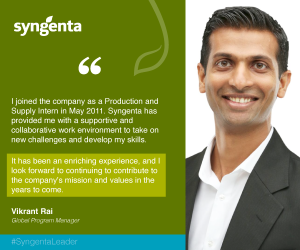Editor's note: This is the first installment of a five-part series, "The Great Farm and Food Talent Search," exploring the challenges and opportunities facing the agriculture and food sectors when it comes to attracting and retaining the skilled, diverse workforce the industry needs.
Keith Stahler, who oversees hiring for a major East Coast pork producer and packer, Clemens Food Group, has experienced firsthand the challenges of finding and keeping the workforce needed to keep plants running and customers happy.
“I think back to five years ago and it was difficult to find people” to work at Clemens’ two pork processing facilities and 25 farms spread across Indiana, North Carolina and Pennsylvania, said Stahler, the company’s director of talent acquisition. “Once COVID hit, the challenge was greater.”
Certain agricultural jobs are not for everyone, especially if a prospective worker did not grow up on a farm. It’s physically demanding with a lot of standing and turning, and sometimes in a cold or less than desirable environment, said Stahler. “It’s one of those industries where there tends to be a higher-than-normal turnover.”
When the pandemic hit, “it was really hard for all industries across the country to find people, but specifically when you’re trying to hire for a position that requires physical labor and a barn or plant work environment,” he said.
Stahler’s challenges were replicated across many sectors in the U.S. as employers in the pre-COVID labor market were already short nearly 1.3 million workers. Today, the pool of workers to fill all U.S. jobs remains tight with as many as 4.4 million workers missing from the labor force with 9.6 million job openings as of August 1, 2023, with only 5.2 million people currently seeking a job.
According to the Bureau of Labor Statistics (BLS), the labor force participation rate in July 2023 came in at 62.6% for the fifth consecutive month, which is still below the pre-pandemic level of 63.4% in February 2020. In June 2023, 3.8 million people willingly left their jobs.
So where did all the workers go?
“Several different labor market demographic challenges started before COVID, but really accelerated based on what COVID brought to the table,” said Julie Davis, senior director of workforce and industry initiatives at the Association of Equipment Manufacturers.
A decrease in the rate of births — on the decline since the 1970s — coupled with lower labor market participation, more job openings, a shortfall of immigrants and a surge of retirements are all creating a workforce problem that is hard to ignore, said Davis.
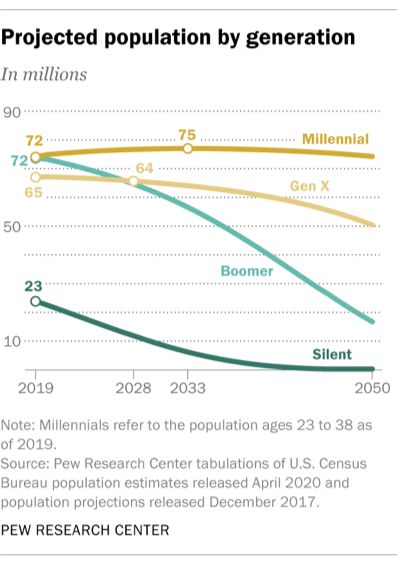
Everyone knew the Baby Boomers were nearing retirement, and the year before the pandemic the yearly average of retiring Boomers was at 2 million people. When COVID hit, that number increased to 3 million by October 2021 as the aging workforce retired faster and earlier than they had previously anticipated, simply because they could, Davis said.
As Boomers exit the workforce, the U.S. population’s slowing birthrate is unable to replace them. While Boomers were born into families with an average of four children each, Boomers themselves had an average of fewer than two children.
Looking ahead, the Congressional Budget Office projects that the U.S. population of retirees — the Social Security-aged population — will increase from 336 million people in 2023 to 373 million people in 2053, outpacing the growth of younger age groups.
Population growth is generally projected to slow between 2023 and 2053, averaging 0.3% per year over that period. Increases “will be increasingly driven by immigration as fertility rates remain below the rate that would be required for a generation to exactly replace itself in the absence of immigration,” CBO said in a January 2023 report.
Davis said the continual decline of the nation's birthrate, which hit new lows in both 2020 and 2021, reinforces the stark reality that “you can’t birth a 30-year-old” to meet current workforce needs. In 65 to 75 years, the aging population will create a complete inverse pyramid with an increasing number of older adults not in the workforce, she said.
Finding 30-year-old workers from other countries around the world is also not feasible. “Immigration is not a long-term solution for us as a nation,” Davis said. Countries around the world are also dealing with lower total populations, which lower unemployment rates and reduce the incentive for people to emigrate to the U.S.
The labor force participation rate for men between 25 and 54 years old fell from 94% in 1980 to 89% in 2019, a drop of 3 million workers, according to The Demographic Drought, a report by labor market analysis firm Lightcast. In addition, men increasingly are choosing to work fewer hours by selecting part-time work over full-time employment. The number of prime-age men willingly working part-time increased from 6 million in 2007 to nearly 8 million in 2019.
Boomers also will be passing their $68 trillion in estimated wealth to prime-age workers and creating a disincentive for some people to be employed. “That transfer of wealth will move to the Millennial generation by 2030, and that is reducing their need to work,” Davis said.
The opioid crisis is also affecting this working age bracket. The Lightcast report said that in 2015 alone, an estimated 860,000 prime-age men were not working due to opioid addiction.
The Great Reconsideration after COVID
Even as fewer young men want to work, need to work, or cannot work, during COVID many workers also started reassessing their reasons for working.
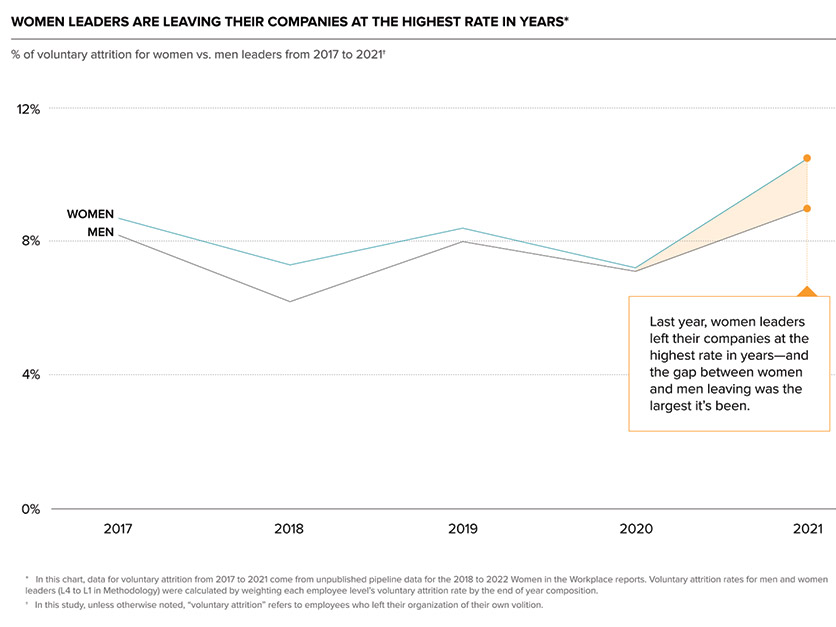 Source: 2022 Women in the Workplace
Source: 2022 Women in the Workplace
According to a Harvard Business Review article, there's a "reconsideration” going on which includes those workers who now look at their jobs with a new perspective. The shift motivated some workers to quit, especially those who may have faced burnout in demanding jobs. The study noted that burnout has “occurred notably among front-line workers, parents and caregivers and organizational leaders.”
Dual-income households were forced to make important decisions coming out of the pandemic. "Because care obligations fall disproportionately on women," industries where women make up a majority of hourly workers have seen a larger number of employees quit, Joseph Fuller and William Kerr wrote in the Harvard Business Review.
A 2022 Women in the Workplace report noted that “29% of women — and 22% of men — have thought about reducing their hours, taking a less demanding job or leaving the workforce altogether, although far fewer have actually taken these actions.”
Ag jobs remain important to overall economy
Agricultural companies are finding ways to attract workers by making a connection to the important role agriculture plays in the overall economy.
Secretary of Agriculture Tom Vilsack often says roughly 20% of the U.S. economy is connected to the food and agriculture industry.
“If you understand and appreciate the significance of the industry, then you also appreciate that when there is a worker shortage, when there are issues and gaps in who is able to work in the field and able to work in these various jobs, you understand that it’s not just a threat to agriculture and food, but it’s also a threat to the overall U.S. economy,” Vilsack said in an interview with Agri-Pulse.

Fewer Americans have a connection to the farm, but jobs in agriculture and related industries, from seed and fertilizer companies to supermarkets and restaurants, represent 15% of the nation’s employment. Some 23 million are directly linked to the food and agriculture sectors, with a combined 46 million jobs linked directly or indirectly, according to the latest Feeding the Economy report, commissioned by 30 food and agriculture groups.
Food and fiber production starts with 2 million farmers and ranchers. There are also scientists, production workers, logistics experts, truck drivers and engineers who work in more than 200,000 food manufacturing, processing and storage facilities. The journey may conclude at one of the nation’s more than 1 million restaurant locations or 100,000 grocers.
Unique challenges in rural workforce
From Florida to California and all the states in between, rural locations have fewer workers to fill millions of agricultural jobs. Current labor conditions have sharply tightened in rural counties with a dependency on agriculture, according to research from Matt Clark, a rural economy analyst for Terrain, a team of economists who provide market and industry analysis to Farm Credit System customers.
“Nationally we have low unemployment rates. However, in rural areas, specifically those driven by agriculture, we have extremely low unemployment rates and the total labor pool to pull from is extremely low,” Clark said in an interview with Agri-Pulse. Much of the rural workforce is “aging or shrinking in size or both. That’s likely going to be a problem for farmers going forward.”
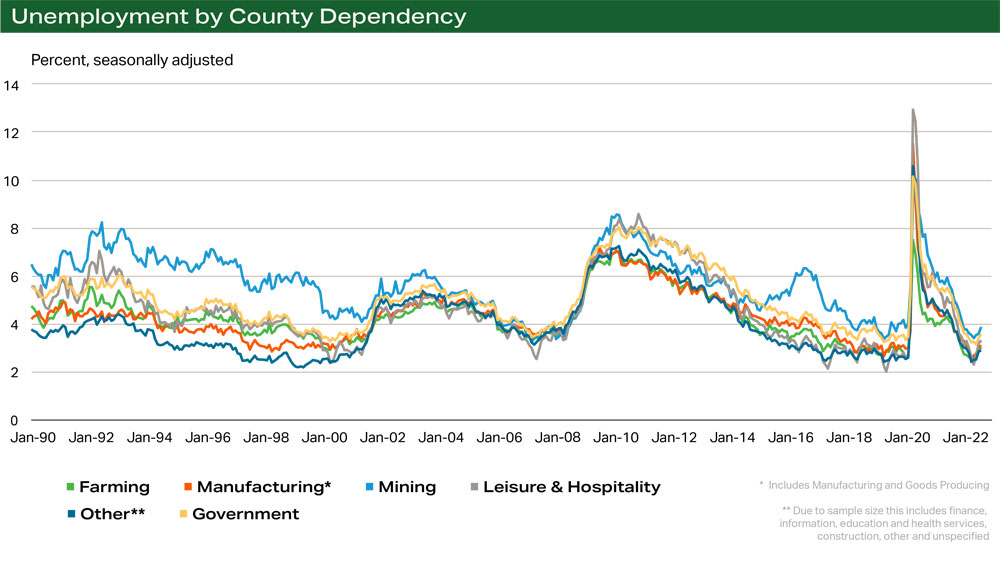 Chart: Matt Clark, Terrain
Chart: Matt Clark, TerrainLow unemployment rates are magnified in rural areas. A non-metropolitan county that has 2,500 people in the labor force and an unemployment rate of 2% has just 50 jobless workers to fill any openings, he said.
It is unlikely that labor force availability will quickly improve in farming communities, in part because of the continued population decline. The population of non-metropolitan farming counties fell 0.28% from 2020 to 2021 as net migration and deaths outpaced births. From 2010 to 2019, the number of people 14 through 64 years old declined by 7% in non-metro counties, Clark said.
According to U.S. Census Bureau data, the current ratio of likely workers (ages 14-64) in rural areas to the total population is 61%, Clark said. That compares to 66% nationwide, and an even higher ratio of 69% in counties with an emphasis on finance, information, education and health.
“This implies that the available pool of labor is likely to remain low in the near future,” Clark said.
Employers also struggle to find specific skill sets in areas where they are needed, said Anne Holiday, vice president of HR operations and talent for Corteva Agriscience.
A survey of 192 Agri-Pulse readers showed that finding workers with the right skills was a challenge for 67% of the respondents. Some 41% of the Agri-Pulse readers said a top challenge is the lack of applicants to fill open positions. Remaining competitive with other businesses for workers was a concern for 38% of the respondents, while 36% pointed to retaining current employees as another challenge.
“I think every company is going to struggle with finding the right people at the right time in the right place that are open for work. I think ag has some unique challenges,” Holiday said.
Angela Latcham, who oversees eight support teams as Corteva’s global seed operations support director at the company’s North America seed production sites and supply chain teams, said her company’s challenge is finding skilled workers for its 40 rural production and research area sites.
Latcham said ag employers also must ensure “people understand that you can have a non-ag background and still have a great and exciting long-term career at Corteva.” Companies continue to recognize the importance of recruiting outside traditional channels for future careers as well as creating specific training or apprenticeship opportunities to create a pipeline of future workers. (Read more about this in part 3 of our series.)
Employers also struggle to get prospective workers to move to where they are needed. The overall relocation rate in 2021 was the lowest in the 70-year record of Census Bureau figures.
Strong demand, but too few ag graduates
The Bureau of Labor Statistics estimates that there will be 141,800 openings for agricultural workers each year, on average, from 2021 through 2031. BLS said most of those openings will be created by workers transferring to different occupations or exiting the labor force.
Another study, conducted every five years by Purdue University in conjunction with USDA’s National Institute of Food and Agriculture, estimates employment opportunities in food and ag-related industries will grow 2.6% between 2020 and 2025 for college graduates with bachelor’s or higher degrees.
Mike Gaul, director of career services at Iowa State University’s College of Agriculture and Life Sciences, informs his incoming agricultural students that it remains a “buyers’ market out there” for new graduates.
“This is as good as it gets. Get in the game and take advantage of it,” Gaul tells his students. Of the 60 new Iowa State agricultural business graduates in May, 54 had a job in hand.
Don't miss a beat sign up for a FREE month of Agri-Pulse news! The latest on what’s happening in Washington, D.C. and around the country in agriculture, just click here.
Similar scenarios are playing out at land grant universities across the country. Mary Ellen Barkley, assistant director of the career center at Kansas State University, said 98% of the class of 2021-22 graduates from the College of Agriculture are employed or furthering their education.
Jill Cords, Michigan State University’s Career Services Network assistant director and career consultant, said hot areas seeking employees include horticulture and landscape and construction and packaging. She said 92.7% of recent graduates from MSU's College of Agriculture and Natural Resources are employed in the ag field.
The Purdue-NIFA study estimated there would be 54,900 job openings annually in food, agriculture, renewable natural resources and the environment during the study outlook until 2025.
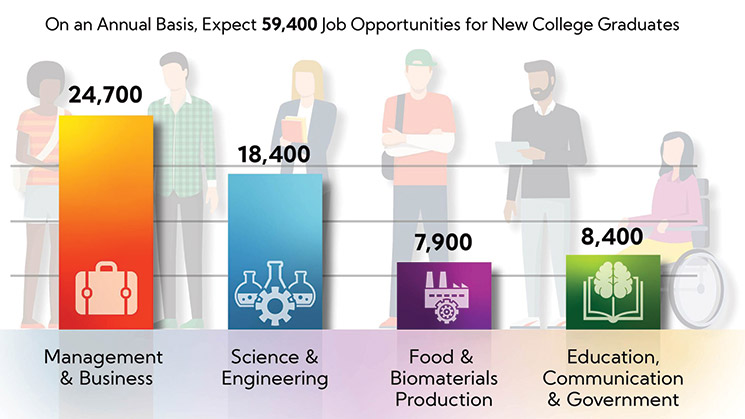 Source: Purdue-NIFA
Source: Purdue-NIFA
Some 61% will be filled by graduates with more traditional food and ag degrees, while the remaining 39% will be from allied fields such as biology, mechanical engineering, accounting and journalism, the report said.
Report author Marcos Fernandez, Purdue's associate dean of agriculture and director of academic programs, said employers’ biggest need is in management, but the number of science and engineering jobs is expected to increase from 15,500 annual job openings in 2015-2020 to 18,400 annually from 2020-2025.
Fernandez said growth in science and engineering jobs will be even greater in the next five years because of the move toward data science and digital agriculture and information systems. As an example, Holiday said Corteva Agriscience plans to heavily invest in its R&D capabilities in the next two years, which will require data scientists and software developers in critical roles to support digitalization and data analysis.
The projected number of education, communication and government jobs also increased from the last survey, going from 7,200 in 2015-2020 to 8,400 from 2020-2025. This includes occupations such as Farm Service Agency employees, Natural Resources Conservation Service specialists, plant and animal inspectors, and more traditional roles such as high school ag teachers and food and agriculture writers.
Earlier this year, NRCS Chief Terry Cosby said he anticipates hiring as many as 3,000 more employees in the next couple of years. NRCS has struggled to retain workers, too. Of the 800 new employees hired in 2022, only 500 stayed on, he said.
Food scientists are in demand along with new graduates in the animal science and health space.
“All of these food companies are screaming for talent out there, even if they’re heavily invested in robotics,” said Iowa State's Gaul.
Agriculture is still a “very promising career path” for individuals who are interested in agriculture or an application of science and business as it relates to agriculture, food and renewable natural resources, said Fernandez. “I don’t think it’s a secret to most of us, obviously, but it’s a secret to many across the country.”
Generational differences require different approaches
AEM’s Davis said for older generations of workers, money was an adequate reward for their labor. “If you look at the younger generations coming into the workforce, it is not that they live to work, they work to live. It is all about work-life balance to them,” Davis said.
Laura Blomme, an executive recruiter for Hedlin Ag Enterprises, said the transition to a younger generation of workers will require companies to rethink workers’ needs.
“As the Boomers are retiring, and we are working through that, the Millennials are the class that is going to be the major source of the workforce for the next several years.” In generalizing Millennials, Blomme said many households feature dual full-time workers, and when a family is involved, it may require more flexibility on the side of employers.
The survey of Agri-Pulse readers asked them why they considered changing jobs; 31% said it was a desire to have an improved work-life balance, while 23% said it was for rebalancing of family life commitments.
Latcham of Corteva said nearly 40% of its North American production workforce has seven or fewer years of experience. This new generation loves to collaborate in groups and is more likely to challenge traditional ways of operating, she noted.
“They like the quickness, and they just want to be efficient. If they can get done in two hours versus six, they’re going to,” she said.
Blomme also said mentorship is paramount to this new generation of employees “who really want to find something that they are passionate about. It’s important for them to feel they’re bringing good value to the business and the job is worth their time.”
Blomme said candidates don't want to change jobs every year, but also don't limit themselves if new opportunities present themselves as a way to advance their careers.
“Realistically, individuals who are ambitious and driven are going to be looking for growth and advancement, whether that’s with the company they’re with or somewhere else,” Blomme said.
If employers position the opportunities correctly, Vilsack said jobs in food and agriculture can represent something that other career opportunities do not: a role that has a deeper meaning and sense of value drawn from making a difference in the world.
“If you want to make a difference, if you want your life to be meaningful, if you want to help your fellow man, if you want to impact and affect global security, if you want to maintain national security here at home, if you want to be your own boss, if you want to be in an area that’s constantly evolving with constant challenges, but allows you to feel a sense of connection to the earth and to the environment, there’s not a better opportunity than food and agriculture,” Vilsack said.
The second part of "The Great Farm and Food Talent Search" will look in depth at what employers are having to do to recruit and retain workers.
For more news, go to www.Agri-Pulse.com.



